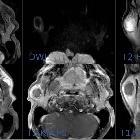Pleomorphes Adenom










Pleomorphic adenomas, also known by the misnomer benign mixed tumors (BMTs), are benign epithelial neoplasms related to glandular tissue. They have a small but real risk of malignant transformation.
For a discussion of specific sites of pleomorphic adenoma, please refer to
- pleomorphic adenoma of the salivary glands
- pleomorphic adenoma of the lacrimal glands
- pleomorphic adenoma of the thorax
Terminology
Historically pleomorphic adenomas have also been called benign mixed tumors, however this name is now discouraged. It was previously thought that these were a form of teratoma, however it is now clear that the neoplasm forms from a single layer of germ cells and is purely epithelial in nature .
Pathology
Location
Pleomorphic adenoma most commonly occurs in salivary glands (especially parotid gland) but can arise in any tissue that has glandular myoepithelial tissue. Other reported sites include lacrimal glands, external auditory canal, skin, breast, and vulva .
Microscopic appearance
These tumors characteristically have a mix of epithelial and mesenchymal tissues . There is a spectrum of histological appearances (thus the term pleomorphic) but commonly includes ductal epithelium, myoepithelial cells, and myxoid stroma.
Treatment and prognosis
A large pleomorphic adenoma can be disfiguring or exert mass effect on important structures. More importantly, they have a proven risk (5-15%) of undergoing malignant transformation (carcinoma ex pleomorphic adenoma, or malignant mixed tumor) . Thus, complete surgical resection is the treatment of choice.
Local recurrent pleomorphic adenoma (RPA) occurs in a small proportion (<5%), up to 20 years after excision .
Siehe auch:
- pleomorphes Adenom der Glandula parotis
- Warthin-Tumor
- Adenoid-zystisches Karzinom
- myoepithelioma
- Schwannom des Nervus facialis
- mukoepidermoides Karzinom
- multiple pleomorphic adenomas
- parapharyngeal pleomorphic adenoma
und weiter:
- Parotistumoren
- Tumoren der Speicheldrüsen
- Azinuszellkarzinom der Speicheldrüse
- myxoide Tumoren
- Vergrößerung der Glandula parotis
- benign minor salivary gland pathology
- malignant mixed tumours of salivary glands
- pleomorphic adenoma of the soft palate
- metastasising pleomorphic adenoma
- pleomorphic adenoma fat containing
- Pleomorphes Adenom der Speicheldrüsen
- Rezidiv pleomorphes Adenom der Glandula parotis

 Assoziationen und Differentialdiagnosen zu Pleomorphes Adenom:
Assoziationen und Differentialdiagnosen zu Pleomorphes Adenom:



